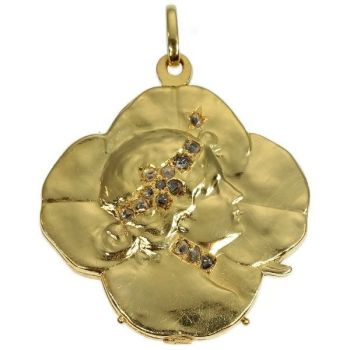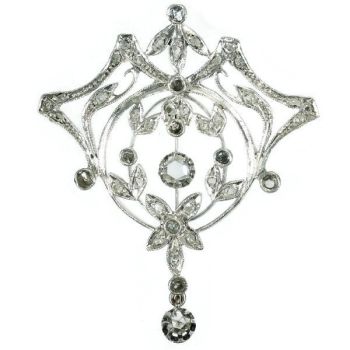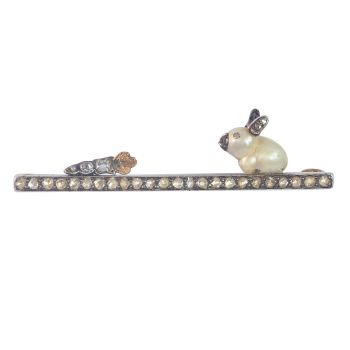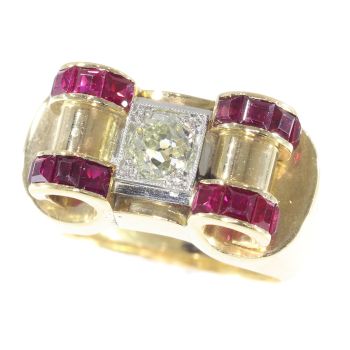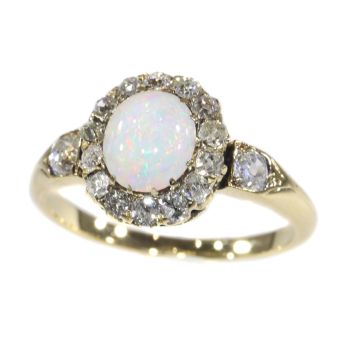Medalhão esmaltado da Belle Epoque em ouro antigo, feito no Império Austro-Húngaro 1910
Artista Desconhecido
Adin Fine Antique Jewellery
- Sobre arte
Antique jewelry object group: locket
Condition: excellent condition
- (more info on our condition scale)
Country of origin: Austria-Hungaria
Style: Belle Époque - The Belle Époque (French for "Beautiful Era") was a period in European social history that began during the late 19th century and lasted until World War I. Occurring during the time of the French Third Republic and theGerman Empire, the "Belle Époque" was named in retrospect, when it began to be considered a "golden age" the major powers of Europe, new technologies improved lives and the commercial arts adapted Renaissance and eighteenth-century styles tomodern forms. In the newly rich United States, emerging from the Panic of 1873, the comparable epoch was dubbed the Gilded Age. In the United Kingdom, this epoch overlaps the end of what is called the Victorian Era there and the period named theEdwardian Era. or more info on styles
Style specifics: The Belle Époque (French for "Beautiful Era") was a period in European social history that began during the late 19th century from the Franco-Prussian War (1870-1871) and lasted until World War I (1914-18).
Occurring during the time of the French Third Republic and the German Empire, the "Belle Époque" was named in retrospect, when it began to be considered a "golden age" the major powers of Europe, new technologies improved lives and the commercialarts adapted Renaissance and eighteenth-century styles to modern forms.
In the newly rich United States, emerging from the Panic of 1873, the comparable epoch was dubbed the Gilded Age. In the United Kingdom, this epoch overlaps the end of what is called the Victorian Era there and the period named the Edwardian Era.
In the Belle Époque cheap coal and cheap labour contributed to the cult of the orchid and made possible the perfection of fruits grown under glass, as the apparatus of state dinners extended to the upper classes; champagne was perfected during the Belle Époque. Exotic feathers and furs were more prominently featured in fashion than ever before, as haute couture was invented in Paris, the centre of the Belle Époque, where fashion began to move in a yearly cycle; in Paris restaurantssuch as Maxim's achieved a new splendour and cachet as places for the rich to parade, and the Opéra Garnier devoted enormous spaces to staircases as similar show places.
After mid-century, railways linked all the major cities of Europe to spa towns like Biarritz and Deauville; their carriages were rigorously divided into first-class and second-class, but the super-rich now began to commission private railway coaches, asexclusivity was a hallmark of opulent luxury. Bohemian lifestyles gained a different glamour, pursued in the cabarets of Montmartre.
Period: ca. 1910
- (events & facts of this era, poetry of this era, fashion of this era)
Theme: basket with bouquet of flowers
Material: 18K yellow gold
- (more info on precious metals)
Technique: Enamelling is an old and widely-adopted technology. The ancient Egyptians applied enamels to pottery and stone objects. The ancient Greeks, Celts, Russians, and Chinese also used enameling processes on metal objects. Enamel is the colorful result offusing powdered glass to a substrate by firing, usually between 750 and 850 degrees Celsius. The powder melts and flows and hardens to a smooth, durable vitreous coating on metal, glass or ceramic. According to some sources, the word enamel comes fromthe High German word smelzan (to smelt) via the Old French esmail. Used as a noun, "an enamel" is a usually small decorative object, coated with enamel coating, such as a champlevé or a cloisonné (different techniques).
Extra information: Austria-Hungary - Austria-Hungary, was a constitutional monarchic union between the crowns of the Austrian Empire and the Kingdom of Hungary in Central Europe, which operated from 1867 to October 1918, following the end of World War I. The union was aresult of the Austro-Hungarian Compromise of 1867, under which the House of Habsburg agreed to share power with the separate Hungarian government, dividing the territory of the former Austrian Empire between them. The Austrian and the Hungarian landsbecame independent entities enjoying equal status.
Austria-Hungary was a multinational realm and one of the world's great powers at the time. Austria-Hungary was geographically the second largest country in Europe after the Russian Empire, and the third most populous (after Russia and the German Empire). The Empire built up the fourth largest machine building industry of the world (after the United States, German Empire and the United Kingdom).
The dual monarchy existed for 51 years until it dissolved on 31 October 1918 at the end of World War I. Many modern-day nation states have emerged in the territory formerly belonging to the realm. These include Austria, Hungary, Slovenia, Bosnia andHerzegovina, Croatia, the Czech Republic, Slovakia, large parts of Serbia and Romania, and smaller parts of Italy, Montenegro, Poland and Ukraine. (from: Wikipedia)
Hallmarks: Austrian-Hungarian hallmarks used between 1901 and 1921
- (more info on hallmarks)
Dimensions: diameter 2,70 cm (1,06 inch)
Weight: 8,50 gram (5,47 dwt)
Reference Nº: 19033-0008
Copyright photography: Adin, fine antique jewelry
- Sobre artista
Pode acontecer que um artista ou criador seja desconhecido.
Algumas obras não devem ser determinadas por quem são feitas ou são feitas por (um grupo de) artesãos. Exemplos são estátuas dos tempos antigos, móveis, espelhos ou assinaturas que não são claras ou legíveis, mas também algumas obras não são assinadas.
Além disso, você pode encontrar a seguinte descrição:
•"Atribuído a …." Na opinião deles, provavelmente uma obra do artista, pelo menos em parte
• “Estúdio de…” ou “Oficina de” Em sua opinião um trabalho executado no estúdio ou oficina do artista, possivelmente sob sua supervisão
• "Círculo de ..." Na opinião deles, uma obra da época do artista mostrando sua influência, intimamente associada ao artista, mas não necessariamente seu aluno
•“Estilo de…” ou “Seguidor de…” Na opinião deles, um trabalho executado no estilo do artista, mas não necessariamente por um aluno; pode ser contemporâneo ou quase contemporâneo
• "Maneira de ..." Na opinião deles, uma obra no estilo do artista, mas de data posterior
•"Depois …." Na opinião deles uma cópia (de qualquer data) de uma obra do artista
• “Assinado…”, “Datado…” ou “Inscrito” Na opinião deles, a obra foi assinada/datada/inscrita pelo artista. A adição de um ponto de interrogação indica um elemento de dúvida
• "Com assinatura ….”, “Com data ….”, “Com inscrição ….” ou “Tem assinatura/data/inscrição” na opinião deles a assinatura/data/inscrição foi adicionada por outra pessoa que não o artista
Você está interessado em comprar esta obra de arte?
Artwork details
Related artworks
Unbekannter Künstler
A large Japanese Imari porcelain 'VOC Groningen' dish1800 - 1925
Preis auf AnfrageZebregs & Röell - Fine Art - Antiques
1 - 4 / 12Unbekannter Künstler
Bvlgari Tubas Halskette1900
Preis auf AnfrageAns Hemke-Kuilboer Juwelier & Antiquair
1 - 4 / 24- 1 - 4 / 24
Ans Hemke-Kuilboer
Solitaire Diamant Ohrstecker2000 - 2017
Preis auf AnfrageAns Hemke-Kuilboer Juwelier & Antiquair
Samuel Dejong
Anatomia Blue Heritage, Atlas Closed2017 - 2019
Preis auf AnfrageVilla del Arte Galleries
1 - 4 / 24- 1 - 4 / 12
















